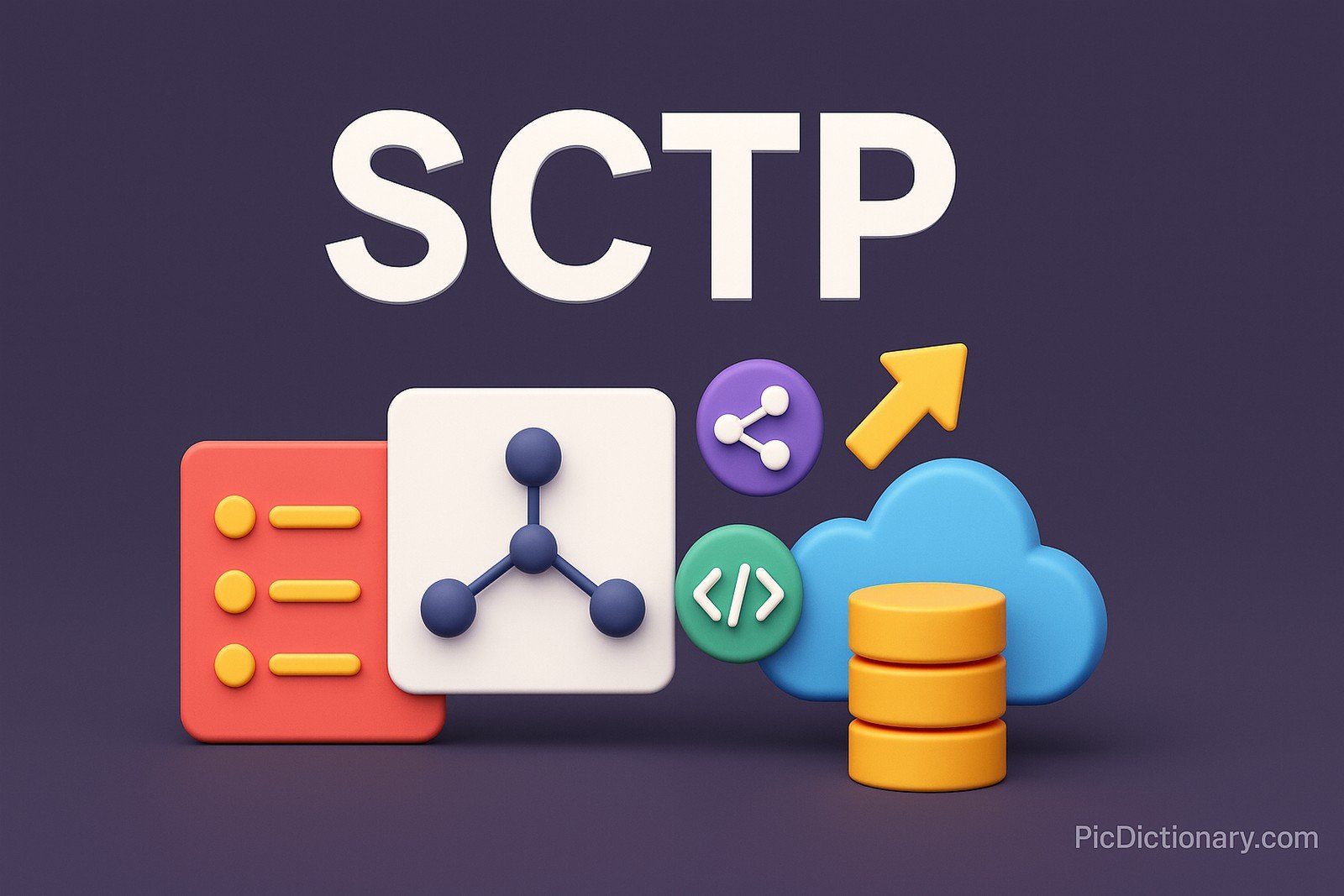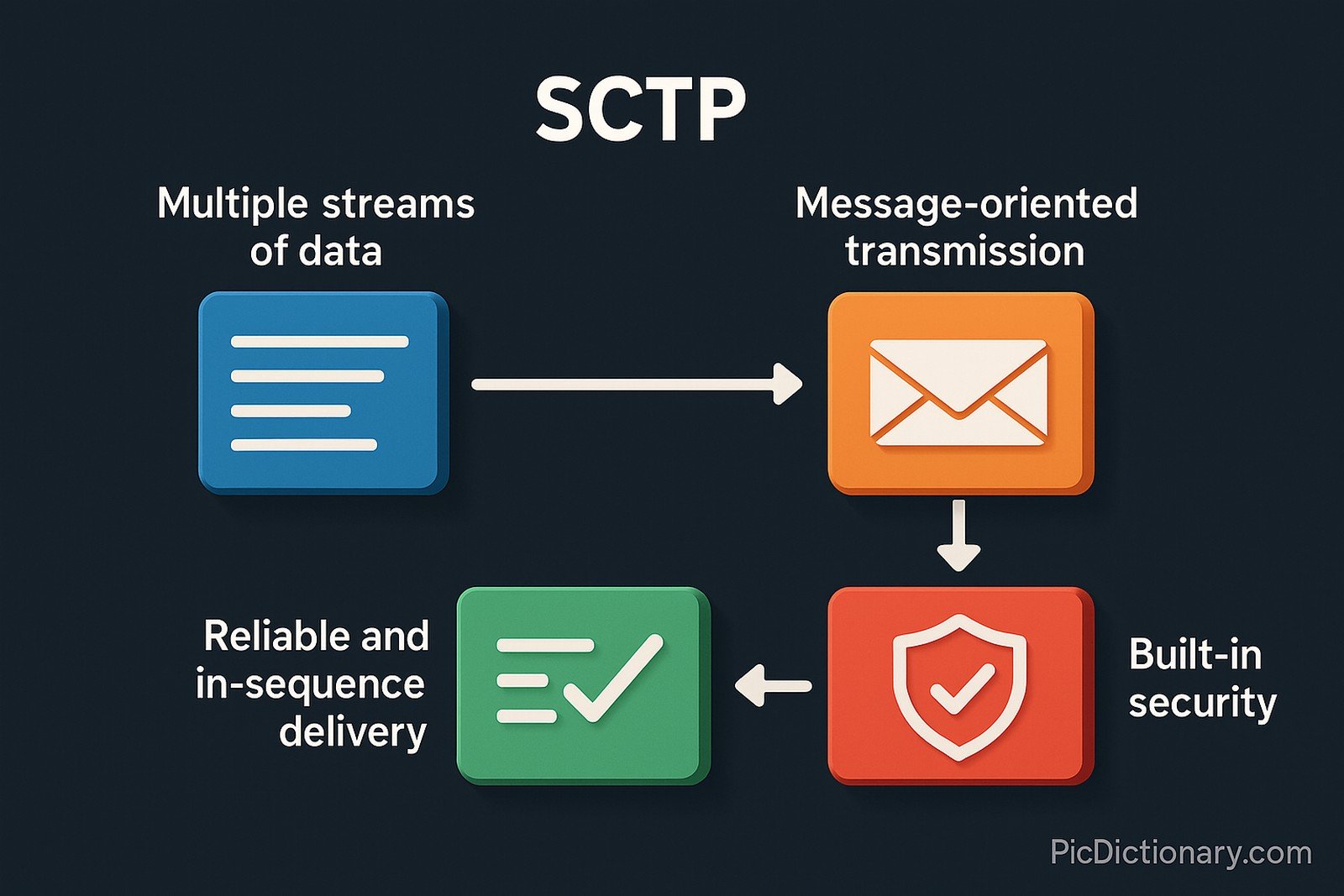Stream Control Transmission Protocol (SCTP)

Quick Navigation:
- Stream Control Transmission Protocol (SCTP) Definition
- Stream Control Transmission Protocol (SCTP) Explained Easy
- Stream Control Transmission Protocol (SCTP) Origin
- Stream Control Transmission Protocol (SCTP) Etymology
- Stream Control Transmission Protocol (SCTP) Usage Trends
- Stream Control Transmission Protocol (SCTP) Usage
- Stream Control Transmission Protocol (SCTP) Examples in Context
- Stream Control Transmission Protocol (SCTP) FAQ
- Stream Control Transmission Protocol (SCTP) Related Words
Stream Control Transmission Protocol (SCTP) Definition
Stream Control Transmission Protocol (SCTP) is a transport-layer communication protocol used for transmitting multiple streams of data between two endpoints simultaneously. Unlike TCP, which is stream-oriented, SCTP supports message-oriented transmission and ensures both reliable and in-sequence delivery of messages across multiple streams within a single connection. SCTP also includes features like multi-homing and built-in security measures to protect against common attacks like SYN flooding.
Stream Control Transmission Protocol (SCTP) Explained Easy
Think of SCTP like sending packages in separate boxes through different delivery trucks, all arriving safely and in order. If one truck is late, the others still arrive on time, and everything is tracked so nothing gets lost. This helps computers talk to each other by sending multiple pieces of information at once without getting confused.
Stream Control Transmission Protocol (SCTP) Origin
SCTP was developed by the Internet Engineering Task Force (IETF) and first published in RFC 2960 in the year 2000. It was designed to overcome certain limitations of existing protocols like TCP and UDP, especially in telephony signaling applications where reliability and order were crucial.
Stream Control Transmission Protocol (SCTP) Etymology
The name refers to its ability to control multiple independent streams of data transmission over a single protocol connection.
Stream Control Transmission Protocol (SCTP) Usage Trends
SCTP is predominantly used in telecom networks, especially for carrying signaling messages in protocols like SS7 over IP. Over time, it has also found application in WebRTC and some security-sensitive data transmission scenarios. While less widespread than TCP or UDP in general internet applications, SCTP remains important where multi-stream reliability and order are critical.
Stream Control Transmission Protocol (SCTP) Usage
- Formal/Technical Tagging:
- Transport Layer
- Networking Protocol
- Data Transmission - Typical Collocations:
- "SCTP association"
- "SCTP multi-homing"
- "SCTP stream reliability"
- "SCTP versus TCP"
Stream Control Transmission Protocol (SCTP) Examples in Context
- Mobile networks use SCTP to carry signaling traffic between switches and controllers.
- WebRTC data channels can use SCTP for reliable message delivery between peers.
- High-reliability industrial control systems use SCTP to ensure timely and secure communication between components.
Stream Control Transmission Protocol (SCTP) FAQ
- What is SCTP?
SCTP is a transport protocol used for sending multiple reliable data streams between computers. - How does SCTP differ from TCP?
SCTP supports multiple streams within a connection, reducing head-of-line blocking and allowing more efficient data delivery. - What applications commonly use SCTP?
SCTP is widely used in telecom signaling, WebRTC, and systems requiring reliable and ordered data delivery. - Does SCTP have built-in security features?
Yes, SCTP includes protection against SYN flooding and certain spoofing attacks. - What is multi-homing in SCTP?
Multi-homing allows an SCTP connection to use multiple IP addresses for redundancy and failover. - Is SCTP faster than TCP?
Not necessarily faster, but it reduces delays in multi-stream scenarios by avoiding head-of-line blocking. - Is SCTP supported on all operating systems?
SCTP is supported on most major operating systems but may require specific configurations or modules. - Can SCTP be used for real-time applications?
Yes, it is suitable for real-time signaling and communication where reliability and low delay matter. - How do SCTP streams work?
SCTP allows multiple independent streams within one connection, reducing interference between different data flows. - Why is SCTP not as common as TCP or UDP?
Due to complexity and limited application scenarios, SCTP adoption is more focused on specific critical use cases.

Stream Control Transmission Protocol (SCTP) Related Words
- Categories/Topics:
- Networking
- Telecommunications
- Transport Layer Protocols
Did you know?
SCTP was initially developed to carry telephone signaling messages but later found its way into other fields, including WebRTC and secure communication applications, thanks to its robust multi-stream and multi-homing capabilities.
PicDictionary.com is an online dictionary in pictures. If you have questions or suggestions, please reach out to us on WhatsApp or Twitter.Authors | Arjun Vishnu | @ArjunAndVishnu

I am Vishnu. I like AI, Linux, Single Board Computers, and Cloud Computing. I create the web & video content, and I also write for popular websites.
My younger brother, Arjun handles image & video editing. Together, we run a YouTube Channel that's focused on reviewing gadgets and explaining technology.



Comments powered by CComment